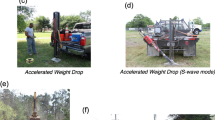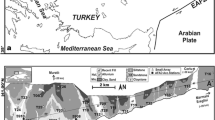Abstract
Landslides with a shallow and complex bedrock layer, where bedrock topography affects the stability of the slide, are a widespread phenomenon. The current methods for evaluating such landslides include conventional in situ methods and array-based geophysical methods. However, these methods are not capable of characterizing the complete spatial extent of the bedrock layer cost-effectively and are difficult to conduct for steep slopes. Therefore, in this study, microtremor horizontal to vertical spectral ratio (MHVSR) is proposed as an effective tool when used in conjunction with other methods to improve our understanding of the landslide. In this study, the method is used to make a tight grid of MHVSR measurements within the landslide. Using this method, a 3D image of bedrock topography can be created over a larger spatial extent to reveal the potential critical landslide zones. This method is employed for two active landslides that have recently experienced considerable movements. Using the MHVSR, several bowl-shaped features were detected in the bedrock layer, which were not detected using conventional invasive in situ methods. These features play a key role in landslide behavior as they can trap water and create a fully saturated soft zone within the critical slide. Missing such key features in the geologic model of the landslide can lead to errors in the slope stability models and cost overruns in rehabilitation efforts. The grid pattern MHVSR method used in this study offers a simple, rapid, and cost-effective tool for landslide site characterization for sites with shallow and complex bedrock topography.













Similar content being viewed by others
References
Arai H, Tokimatsu K (1998) The effects of surface geology on seismic motion: recent progress and new horizon on ESG study. Proceeding of the Second International Symposium on the Effects of Surface Geology on Seismic Motion, Japan, December 1–3:673–680
Berti M, Bertello L, Squarzoni G (2019) Surface-wave velocity measurements of shear stiffness of moving earthflows. Landslides 16(3):469–484
Bichler A, Bobrowsky P, Best M, Douma M, Hunter J, Calvert T, Burns R (2004) Three-dimensional mapping of a landslide using a multi-geophysical approach: the Quesnel Forks landslide. Landslides 1(1):29–40
Burjánek J, Gassner-Stamm G, Poggi V, Moore JR, Fäh D (2010) Ambient vibration analysis of an unstable mountain slope. Geophys J Int 180(2):820–828
Buttle JM, Dillon PJ, Eerkes GR (2004) Hydrologic coupling of slopes, riparian zones and streams: an example from the Canadian Shield. J Hydrol 287(1-4):161–177
Cox BR, Cheng T, Vantassel JP, Manuel L (2020) A statistical representation and frequency-domain window-rejection algorithm for single-station HVSR measurements. Geophys J Int 221(3):2170–2183
Delgado J, Galiana-Merino JJ, García-Tortosa FJ, Garrido J, Lenti L, Martino S, Peláez JA, Rodríguez-Peces MJ, Galdeano CSD, Soler-Llorens JL (2021) Ambient noise measurements to constrain the geological structure of the Güevéjar landslide (S Spain). Appl Sci 11(4):1454
Earthimager 2D, AGIUSA. (2019).
Eker AM, Koçkar MK, Akgün H (2015) Evaluation of site effect within the tectonic basin in the northern side of Ankara. Eng Geol 192:76–91
Fabbrocino S, Lanzano G, Forte G, de Magistris FS, Fabbrocino G (2015) SPT blow count vs. shear wave velocity relationship in the structurally complex formations of the Molise Region (Italy). Eng Geol 187:84–97
Falae PO, Dash RK, Kanungo DP, Chauhan PKS (2021) Interpretation on water seepage and degree of weathering in a landslide based on pre-and post–monsoon electrical resistivity tomography. Near Surface Geophysics
Foti, S. (2000). Multistation methods for geotechnical characterization using surface waves (p. 229). na.
Friedel S, Thielen A, Springman SM (2006) Investigation of a slope endangered by rainfall-induced landslides using 3D resistivity tomography and geotechnical testing. J Appl Geophys 60(2):100–114
Graham CB, Woods RA, McDonnell JJ (2010) Hillslope threshold response to rainfall: (1) a field based forensic approach. J Hydrol 393(1-2):65–76
Hibert C, Grandjean G, Bitri A, Travelletti J, Malet JP (2012) Characterizing landslides through geophysical data fusion: example of the La Valette landslide (France). Eng Geol 128:23–29
Jongmans D, Garambois S (2007) Geophysical investigation of landslides: a review. Bulletin de la Société géologique de France 178(2):101–112
Koehn WJ, Tucker-Kulesza SE, LeBow V, Rahimi S, Bernhardt ML, Wood CM (2019) Enhanced analysis of landslide failure mechanisms in the Ozark Plateau Region with near surface geophysics. Geocongress 2019, Philadelphia, USA. https://doi.org/10.1061/9780784482131.021
Konno K, Ohmachi T (1998) Ground-motion characteristics estimated from spectral ratio between horizontal and vertical components of microtremor. Bulletin of the Seismological Society of America 88(1):228–241
Lanni C, McDonnell J, Hopp L, Rigon R (2013) Simulated effect of soil depth and bedrock topography on near-surface hydrologic response and slope stability. Earth Surf Process Landf 38(2):146–159
Lapenna V, Lorenzo P, Perrone A, Piscitelli S, Sdao F, Rizzo E (2003) High-resolution geoelectrical tomographies in the study of Giarrossa landslide (southern Italy). Bull Eng Geol Environ 62(3):259–268
Lin Y C, Joh S H, and Stokoe K H (2014). Analyst J: analysis of the UTexas 1 surface wave dataset using the SASW methodology. In Geo-Congress 2014: Geo-characterization and Modeling for Sustainability (pp. 830-839)
Lu K, Li F, Pan J, Li K, Chen Y, Li Y et al (2021) Using electrical resistivity tomography and surface nuclear magnetic resonance to investigate cultural relic preservation in Leitai. China Engineering Geology 106042
Malischewsky PG, Scherbaum F (2004) Love’s formula and H/V-ratio (ellipticity) of Rayleigh waves. Wave Motion 40(1):57–67
Merritt AJ, Chambers JE, Murphy W, Wilkinson PB, West LJ, Gunn DA, Meldrum PI, Kirkham M, Dixon N (2014) 3D ground model development for an active landslide in Lias mudrocks using geophysical, remote sensing and geotechnical methods. Landslides 11(4):537–550
Nakamura Y (1989) A method for dynamic characteristics estimation of subsurface using microtremor on the ground surface. Q Report of RTRI 30(1):25–33
Naudet V, Lazzari M, Perrone A, Loperte A, Piscitelli S, Lapenna V (2008) Integrated geophysical and geomorphological approach to investigate the snowmelt-triggered landslide of Bosco Piccolo village (Basilicata, southern Italy). Eng Geol 98(3-4):156–167
Okada Y, Konishi C (2019) Geophysical features of shallow landslides induced by the 2015 Kanto-Tohoku heavy rain in Kanuma city, Tochigi Prefecture, Japan. Landslides 16(12):2469–2483
Panzera F, D’Amico S, Lotteri A, Galea P, Lombardo G (2012) Seismic site response of unstable steep slope using noise measurements: the case study of Xemxija Bay area, Malta. Nat Hazards Earth Syst Sci 12(11):3421–3431
Park CB, Miller RD, Xia J (1999) Multichannel analysis of surface waves. Geophysics 64(3):800–808
Peng J, Wang G, Wang Q, Zhang F (2017) Shear wave velocity imaging of landslide debris deposited on an erodible bed and possible movement mechanism for a loess landslide in Jingyang, Xi’an, China. Landslides 14(4):1503–1512
Perrone A, Lapenna V, Piscitelli S (2014) Electrical resistivity tomography technique for landslide investigation: a review. Earth Sci Rev 135:65–82
Perrone A, Canora F, Calamita G, Bellanova J, Serlenga V, Panebianco S, Tragni N, Piscitelli S, Vignola L, Doglioni A, Simeone V, Sdao F, Lapenna V (2021) A multidisciplinary approach for landslide residual risk assessment: the Pomarico landslide (Basilicata Region, Southern Italy) case study. Landslides 18(1):353–365
Rahimi S, Wood CM, Coker F, Moody T, Bernhardt-Barry M, Kouchaki BM (2018) The combined use of MASW and resistivity surveys for levee assessment: a case study of the Melvin Price Reach of the Wood River Levee. Eng Geol 241:11–24. https://doi.org/10.1016/j.enggeo.2018.05.009
Rahimi S, Moody T, Wood C, Kouchaki BM, Barry M, Tran K, King C (2019a) Mapping subsurface conditions and detecting seepage channels for an embankment dam using geophysical methods: a case study of the Kinion Lake Dam. J Environ Eng Geophys 24(3):373–386. https://doi.org/10.2113/JEEG24.3.373
Rahimi S, Wood CM, Bernhardt-Barry M, Himel AK (2019b, March) Updated reference shear wave velocity curves for near-surface site characterization. In: Geo-Congress 2019: Engineering Geology, Site Characterization, and Geophysics. American Society of Civil Engineers, Reston, VA, pp 324–333. https://doi.org/10.1061/9780784482131.033
Rahimi S, Wood CM, Wotherspoon LM (2020a) Influence of soil aging on SPT-Vs correlation and seismic site classification. Eng Geol 105653:105653. https://doi.org/10.1016/j.enggeo.2020.105653
Rahimi S, Wood CM, Himel AK (2020b, February) Application of microtremor horizontal to vertical spectra ratio (MHVSR) and multichannel analysis of surface wave (MASW) for shallow bedrock mapping for transportation projects. In: Geo-Congress 2020: Modeling, Geomaterials, and Site Characterization. American Society of Civil Engineers, Reston, VA, pp 622–632. https://doi.org/10.1061/9780784482803.066
Rahimi S, Wood CM, Kokkali P, Rivers B (2021) Advantages of geophysics to improve site characterization and reliability for transportation projects. Transp Res Rec:036119812199636. https://doi.org/10.1177/0361198121996362
SeisImager 2D manual, Geometric. (2019).
SESAME European Research Project. (2004). Guidelines for the implementation of the H/V spectral ratio technique on ambient vibration. Measurements, processing and interpretations. Project No. EVG1-CT-2000-00026.
Teague D, Cox B, Bradley B, Wotherspoon L (2018) Development of deep shear wave velocity profiles with estimates of uncertainty in the complex interbedded geology of Christchurch, New Zealand. Earthquake Spectra 34(2):639–672
Wood CM, Deschenes M, Ledezma C, Meneses J, Montalva G, Morales-Velez AC (2019) Dynamic site characterization of areas affected by the 2017 Puebla-Mexico city earthquake. Soil Dyn Earthq Eng 125:105704. https://doi.org/10.1016/j.soildyn.2019.105704
Xu XQ, Su LJ, Zhu HH (2017) Analysis on shear wave velocity structure of a gravel landslide based on dual-source surface wave method. Landslides 14(3):1127–1137
Yilar E, Baise LG, Ebel JE (2017) Using H/V measurements to determine depth to bedrock and V s30 in Boston, Massachusetts. Eng Geol 217:12–22
Author information
Authors and Affiliations
Corresponding author
Rights and permissions
About this article
Cite this article
Rahimi, S., Wood, C.M. & Bernhardt-Barry, M. The MHVSR technique as a rapid, cost-effective, and noninvasive method for landslide investigation: case studies of Sand Gap and Ozark, AR, USA. Landslides 18, 2705–2720 (2021). https://doi.org/10.1007/s10346-021-01677-7
Received:
Accepted:
Published:
Issue Date:
DOI: https://doi.org/10.1007/s10346-021-01677-7




